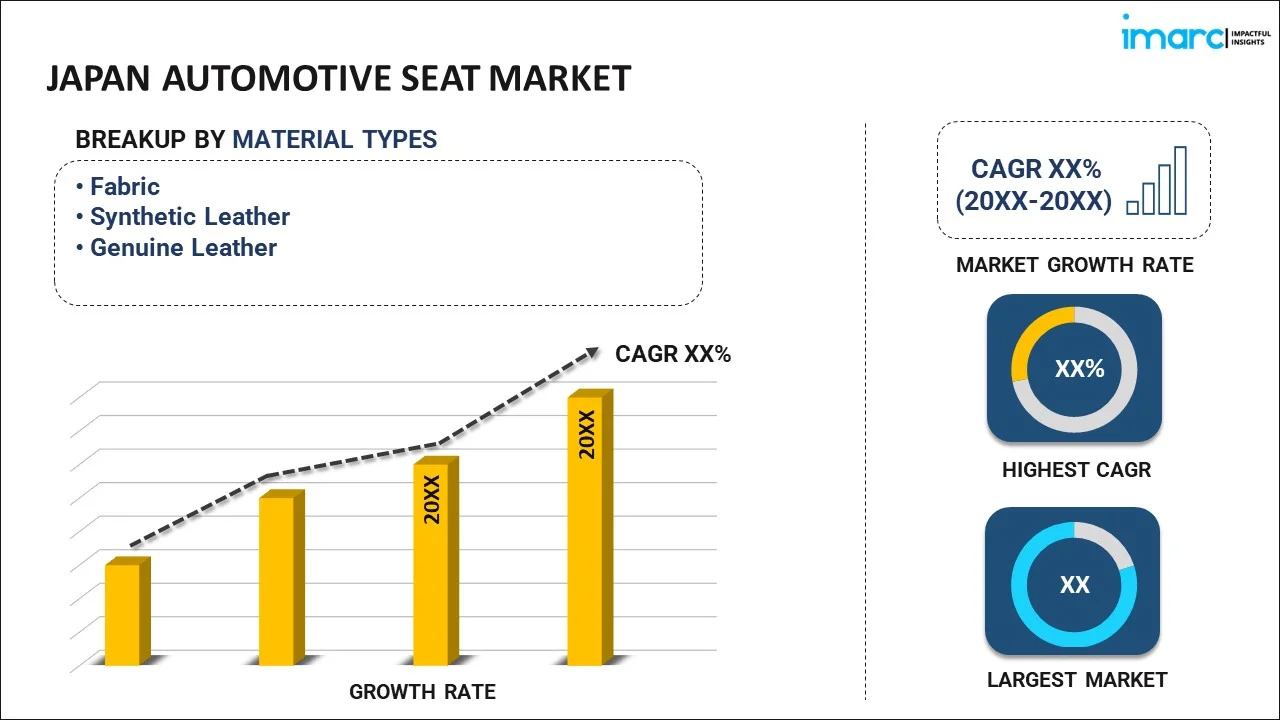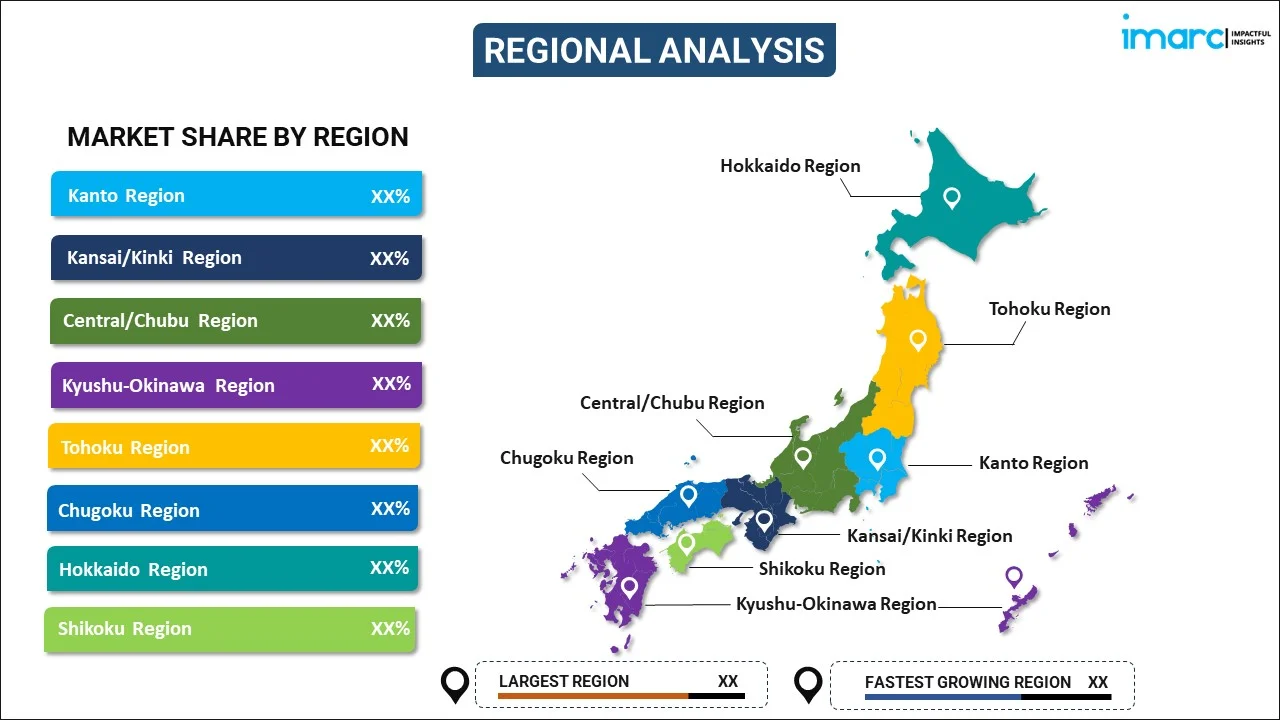
Japan Automotive Seat Market Report by Material Type (Fabric, Synthetic Leather, Genuine Leather), Seat Type (Bucket Seat, Bench Seat), Vehicle Type (Passenger Vehicle, Commercial Vehicle), Vehicle Energy Source (Gasoline, Diesel, Electric, and Others), and Region 2025-2033
Market Overview:
Japan automotive seat market size reached USD 5,346 Million in 2024. Looking forward, IMARC Group expects the market to reach USD 7,921 Million by 2033, exhibiting a growth rate (CAGR) of 4.50% during 2025-2033. Ongoing technological innovation, stringent safety regulations, shifting preference for eco-friendly material, the rising demand for compact vehicle, emerging trends of ride-sharing and taxi services, and the growing demand for aesthetic and customized interior designs represent some of the key factors driving the market.
|
Report Attribute
|
Key Statistics
|
|---|---|
|
Base Year
|
2024 |
|
Forecast Years
|
2025-2033
|
|
Historical Years
|
2019-2024
|
| Market Size in 2024 | USD 5,346 Million |
| Market Forecast in 2033 | USD 7,921 Million |
| Market Growth Rate (2025-2033) | 4.50% |
An automotive seat is an integral component of a vehicle's interior designed to provide comfort, support, and safety for passengers and drivers. It plays a critical role in ensuring a comfortable and ergonomic driving or riding experience while also being a key element in vehicle safety. Modern automotive seats are typically constructed with a sturdy framework, often made of metal, and are equipped with a variety of cushioning materials such as foam, leather, fabric, or synthetic materials to provide both comfort and durability. They are designed to conform to the contours of the human body, offering lumbar support and minimizing fatigue during long journeys. Automotive seats are equipped with features, such as headrests to reduce the risk of whiplash during collisions, seat belts that are integrated into the seat structure, and airbags that may be built into the seat itself. These features contribute to the overall safety of the vehicle's occupants.
Japan Automotive Seat Market Trends:
Japan's persistent focus on innovation and technology has led to the integration of advanced features into automotive seats, including electronic adjustments and heating and cooling functions, which is primarily driving the market growth. Besides this, stringent safety regulations and a strong emphasis on passenger well-being have prompted the development of seats with enhanced safety features such as airbags, anti-whiplash headrests, and seat belt reminders, contributing to the market growth. Moreover, the surging demand for fuel-efficient and eco-friendly vehicles in Japan has driven the adoption of lightweight and eco-friendly seat materials to reduce the overall vehicle weight and carbon emissions, creating a favorable outlook for market expansion. In confluence with this, the aging population in Japan has increased the need for ergonomically designed seats to cater to the comfort and mobility requirements of elderly drivers and passengers, thereby strengthening the market growth. Concurrently, the emerging trend of urbanization and traffic congestion has led to a growing preference for compact vehicles with space-saving and comfortable seat designs, which is aiding in market expansion. In addition to this, the booming ride-sharing and taxi industries in Japan have heightened the demand for durable and easy-to-clean seat materials, such as synthetic leather and stain-resistant fabrics, which, in turn, are presenting lucrative opportunities for market expansion. Furthermore, the evolving automotive design trends, incorporating luxurious and aesthetically pleasing interiors, have fueled the need for visually appealing and customized automotive seats, thereby bolstering the market growth. Apart from this, the flourishing expansion of the electric vehicle (EV) sector, where automakers are investing in innovative seat designs to complement the unique requirements of electric cars, is providing an impetus to the market growth across the country.
Japan Automotive Seat Market Segmentation:
IMARC Group provides an analysis of the key trends in each segment of the market, along with forecasts at the country level for 2025-2033. Our report has categorized the market based on material type, seat type, vehicle type, and vehicle energy source.
Material Type Insights:

- Fabric
- Synthetic Leather
- Genuine Leather
The report has provided a detailed breakup and analysis of the market based on the material type. This includes fabric, synthetic leather, and genuine leather.
Seat Type Insights:
- Bucket Seat
- Bench Seat
A detailed breakup and analysis of the market based on the seat type have also been provided in the report. This includes bucket seat and bench seat.
Vehicle Type Insights:
- Passenger Vehicle
- Commercial Vehicle
The report has provided a detailed breakup and analysis of the market based on the vehicle type. This includes passenger vehicle and commercial vehicle.
Vehicle Energy Source Insights:
- Gasoline
- Diesel
- Electric
- Others
A detailed breakup and analysis of the market based on the vehicle energy source have also been provided in the report. This includes gasoline, diesel, electric, and others.
Regional Insights:

- Kanto Region
- Kansai/Kinki Region
- Central/ Chubu Region
- Kyushu-Okinawa Region
- Tohoku Region
- Chugoku Region
- Hokkaido Region
- Shikoku Region
The report has also provided a comprehensive analysis of all the major regional markets, which include Kanto Region, Kansai/Kinki Region, Central/ Chubu Region, Kyushu-Okinawa Region, Tohoku Region, Chugoku Region, Hokkaido Region, and Shikoku Region.
Competitive Landscape:
The market research report has also provided a comprehensive analysis of the competitive landscape. Competitive analysis such as market structure, key player positioning, top winning strategies, competitive dashboard, and company evaluation quadrant has been covered in the report. Also, detailed profiles of all major companies have been provided.
Japan Automotive Seat Market Report Coverage:
| Report Features | Details |
|---|---|
| Base Year of the Analysis | 2024 |
| Historical Period | 2019-2024 |
| Forecast Period | 2025-2033 |
| Units | Million USD |
| Scope of the Report | Exploration of Historical Trends and Market Outlook, Industry Catalysts and Challenges, Segment-Wise Historical and Future Market Assessment:
|
| Material Types Covered | Fabric, Synthetic Leather, Genuine Leather |
| Seat Types Covered | Bucket Seat, Bench Seat |
| Vehicle Types Covered | Passenger Vehicle, Commercial Vehicle |
| Vehicle Energy Sources Covered | Gasoline, Diesel, Electric, Others |
| Regions Covered | Kanto Region, Kansai/Kinki Region, Central/ Chubu Region, Kyushu-Okinawa Region, Tohoku Region, Chugoku Region, Hokkaido Region, Shikoku Region |
| Customization Scope | 10% Free Customization |
| Post-Sale Analyst Support | 10-12 Weeks |
| Delivery Format | PDF and Excel through Email (We can also provide the editable version of the report in PPT/Word format on special request) |
Key Questions Answered in This Report:
- How has the Japan automotive seat market performed so far and how will it perform in the coming years?
- What has been the impact of COVID-19 on the Japan automotive seat market?
- What is the breakup of the Japan automotive seat market on the basis of material type?
- What is the breakup of the Japan automotive seat market on the basis of seat type?
- What is the breakup of the Japan automotive seat market on the basis of vehicle type?
- What is the breakup of the Japan automotive seat market on the basis of vehicle energy source?
- What are the various stages in the value chain of the Japan automotive seat market?
- What are the key driving factors and challenges in the Japan automotive seat?
- What is the structure of the Japan automotive seat market and who are the key players?
- What is the degree of competition in the Japan automotive seat market?
Key Benefits for Stakeholders:
- IMARC’s industry report offers a comprehensive quantitative analysis of various market segments, historical and current market trends, market forecasts, and dynamics of the Japan automotive seat market from 2019-2033.
- The research report provides the latest information on the market drivers, challenges, and opportunities in the Japan automotive seat market.
- Porter's five forces analysis assist stakeholders in assessing the impact of new entrants, competitive rivalry, supplier power, buyer power, and the threat of substitution. It helps stakeholders to analyze the level of competition within the Japan automotive seat industry and its attractiveness.
- Competitive landscape allows stakeholders to understand their competitive environment and provides an insight into the current positions of key players in the market.
Need more help?
- Speak to our experienced analysts for insights on the current market scenarios.
- Include additional segments and countries to customize the report as per your requirement.
- Gain an unparalleled competitive advantage in your domain by understanding how to utilize the report and positively impacting your operations and revenue.
- For further assistance, please connect with our analysts.
 Inquire Before Buying
Inquire Before Buying
 Speak to an Analyst
Speak to an Analyst
 Request Brochure
Request Brochure
 Request Customization
Request Customization




.webp)




.webp)












